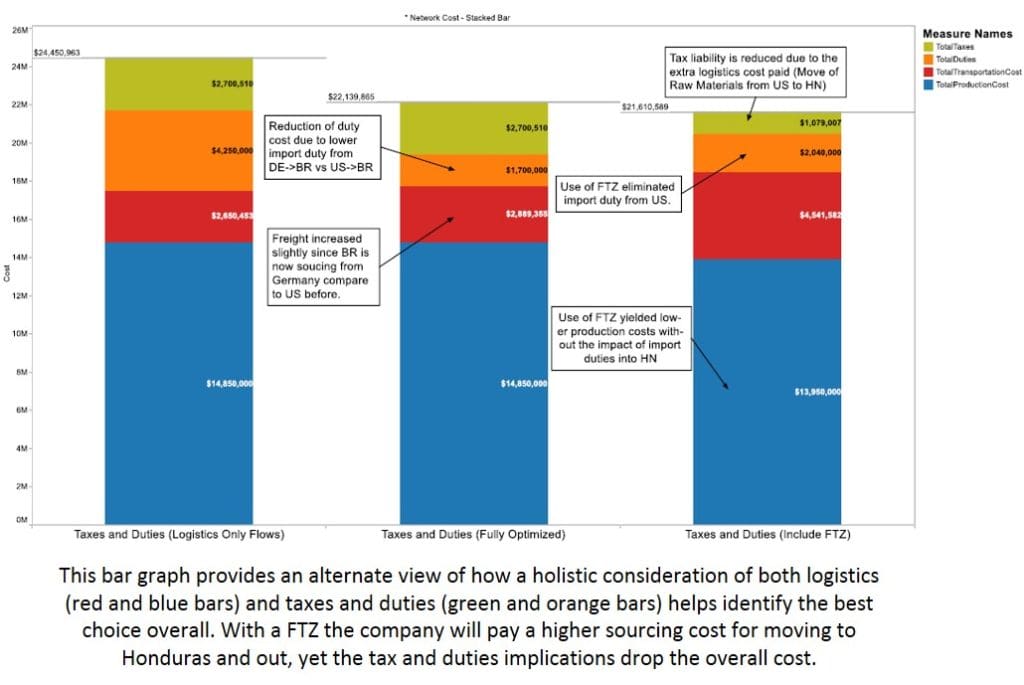There are numerous ways to integrate tax and duties in supply chain design. Here are a few ways to consider both logistics and tax considerations in a holistic view for the best overall design decisions.
The supply chain is core to how your business is run and its costs, profit and growth. With the increasing globalization of business, variable taxes and duties across trading borders have a huge impact on overall cost, supplier sourcing, manufacturing strategies and distribution network structure. However, the inherently complex nature of tax laws, particularly in countries such as Brazil, has obstructed many businesses from including taxes and duties in supply chain design practices. With a global average tax rate of around over 20 percent, the ramifications of this could be staggering—millions of dollars a year may be wasted as a result, but there is also potential to leverage tax and duty optimization for lowest total cost and to elevate competitive advantage.
 Why Consider Taxes and Duties in Supply Chain Design?
Why Consider Taxes and Duties in Supply Chain Design?
Balance: Successful businesses must find the right balance between supply chain costs and tax/duty obligations
Lost Savings: Risk of missing out on potential savings by not considering regional customs regime or trade concessions
Competitiveness: Reduced price/cost competitiveness by not including the use of free trade agreements
Planning: Not reacting fast enough to complicated and often dynamic rules and regulations can have dramatic financial/operational consequences
Long-term Analysis: Identifying the impact of taxes and duties in future strategic moves, such as mergers and acquisitions and supply chain capacity planning, can be a vital component in building competitive advantage and global positioning
Financial Uniformity: Clearly communicating tax and duty-related challenges and opportunities internally is imperative in order to most effectively design and implement supply chain changes. While locally-focused tax calculations may currently be taking place, global optimization with both tax and logistics considerations, aligned with P&L standards, can be a more compelling proposal to stakeholders.
How to Use Modeling Technology for Tax Optimization
By including tax costs and tax credits as well as operational/logistics costs in supply chain design, global businesses can minimize total costs. Modeling technology can be used to:
- Optimize supply chain with holistic view of duties and taxes and perform what-if scenario testing on regulation changes, transfer prices, etc.
- Re-design optimal supply chain strategy based on regulation changes
- Quantify benefits from free trade zones and regional trade concessions
- Measure impact from various taxes such as:
- COFIN/PIS/IPI/ISS/IRPJ/IPTU/ICMS (Brazil)
- Value-added tax (VAT)
- State-to-state tax
- Corporate tax
- Inventory tax
 Indian & Brazilian Tax Structure Example
Indian & Brazilian Tax Structure Example
Both India and Brazil have complex tax structures that leverage taxes on movements of goods between states while also providing credits back to companies for movements into a given facility. These systems of credits and debits create significant incentives that should be considered in supply chain design. Design without tax and duty considerations can lead to inefficiencies and lost cost savings opportunities.
Companies often form multiple corporate entities in countries with complex tax structures to minimize their tax burden. Leveraging supply chain network design tools to optimize not only the logistics but also tax and duty implications leads to a complete picture of how to run your network.
India’s planned shift from VAT and CST (Central Sales Tax) to a more consistent Good and Services Tax (GST) regime means that supply chains need to be designed to best manage the transition. The new system should be easier for companies to track and manage but may leads to higher costs. Given the existing tax structure incentives are distributed across corporate entities for tax avoidance. The new system should allow for more centralization of facilities. Effective transition plans will be needed to determine where consolidation should occur and how aggressive the timing of such changes should be.
Getting Started with Taxes and Duties Optimization
In order to be successful and establish quick wins, start small and build your way up to more complex modeling to answer wider-scope supply chain questions. As you go, evaluate the resulting benefits and how to refine your approach with different technologies and approaches to best fit your business strategy.
 Austin Chrzanowski is the Product Manager of Network Optimization and Transportation Optimization Technologies at LLamasoft. At LLamasoft since 2011, Chrzanowski has worked with customers from multiple industries including food and beverage, healthcare, military, manufacturing and petro-chemical to execute supply chain projects and identify new strategic designs. Prior to LLamasoft he spent time at Pfizer, the U-M Health System, and the Australian Submarine Corporation in Adelaide, Australia. He holds a Master’s Degree in Industrial and Operations Engineering from the University of Michigan.
Austin Chrzanowski is the Product Manager of Network Optimization and Transportation Optimization Technologies at LLamasoft. At LLamasoft since 2011, Chrzanowski has worked with customers from multiple industries including food and beverage, healthcare, military, manufacturing and petro-chemical to execute supply chain projects and identify new strategic designs. Prior to LLamasoft he spent time at Pfizer, the U-M Health System, and the Australian Submarine Corporation in Adelaide, Australia. He holds a Master’s Degree in Industrial and Operations Engineering from the University of Michigan.

















